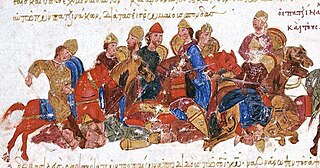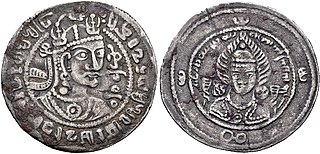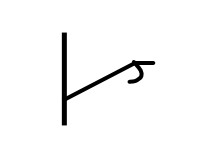Related Research Articles

The Oghuz Turks were a western Turkic people who spoke the Oghuz branch of the Turkic language family. In the 8th century, they formed a tribal confederation conventionally named the Oghuz Yabgu State in Central Asia. Today, much of the populations of Turkey, Azerbaijan and Turkmenistan are descendants of Oghuz Turks. Byzantine sources call them Uzes. The term Oghuz was gradually supplanted by the terms Turkmen and Turcoman by 13th century.

The Pechenegs or Patzinaks were a semi-nomadic Turkic people from Central Asia who spoke the Pecheneg language. In the 9th and 10th centuries, the Pechenegs controlled much of the steppes of southeast Europe and the Crimean Peninsula. In the 9th century the Pechenegs began a period of wars against Kievan Rus', and for more than two centuries launched raids into the lands of Rus', which sometimes escalated into full-scale wars.
The Karluks were a prominent nomadic Turkic tribal confederacy residing in the regions of Kara-Irtysh and the Tarbagatai Mountains west of the Altay Mountains in Central Asia. Karluks gave their name to the distinct Karluk group of the Turkic languages, which also includes the Uzbek, Uyghur and Ili Turki languages.

Mahmud ibn Husayn ibn Muhammad al-Kashgari was an 11th-century Kara-Khanid scholar and lexicographer of the Turkic languages from Kashgar.

The Kayı or Kayi tribe were an Oghuz Turkic people and a sub-branch of the Bozok tribal federation. In his Dīwān Lughāt al-Turk, the 11th century Kara-Khanid scholar Mahmud al-Kashgari cited Kayı as of one of 22 Oghuz tribes, saying that Oghuz were also called Turkomans. The name Kayı means "the one who has might and power by relationship" and the Turkmen proverb says that "people shall be led by Kayi and Bayat tribes".
Alp Er Tunga or Alp Er Tonğa is a mythical Turkic hero who was mentioned in Mahmud al-Kashgari's Dīwān Lughāt al-Turk, Yusuf Balasaguni's Kutadgu Bilig and in the Vatican manuscript of Oghuznama by an unknown writer.
Middle Turkic refers to a phase in the development of the Turkic language family, covering much of the Middle Ages. In particular the term is used by linguists to refer to a group of Karluk and Oghuz and related languages spoken during this period in Central Asia, Iran, and other parts of the Middle East controlled by the Seljuk Turks.

The Oghuz Yabgu State or Oghuz Il was a Turkic state, founded by Oghuz Turks in 766, located geographically in an area between the coasts of the Caspian and Aral Seas. Oghuz tribes occupied a vast territory in Kazakhstan along the Irgiz, Yaik, Emba, and Uil rivers, the Aral Sea area, the Syr Darya valley, the foothills of the Karatau Mountains in Tien-Shan, and the Chui River valley. The Oghuz political association developed in the 9th and 10th centuries in the basin of the middle and lower course of the Syr Darya and adjoining the modern western Kazakhstan steppes.
Yabaku is a fairly enigmatic tribe out of ten prominent Türkic tribes enumerated by Mahmut Kashgari in the list describing the location of the Türkic polities from the borders of the Eastern Roman Empire to the borders of China in the following sequence:
- Bäčänäk;
- Qifčāk;
- Oğuz;
- Yemēk;
- Bašğirt;
- Basmil;
- Qāi;
- Yabāqu;
- Tatār;
- Qirqiz.

The Argyn tribe is a constituent of the Kazakh ethnicity. The Argyn are a component of the Orta jüz. Kazakhs historically consisted of three tribal federations: the Great jüz, Middle jüz, and Little jüz. Karakhanid scholar Mahmud al-Kashgari glossed Arghu as "ravine between two mountains", because the Arghu country was located between Tiraz and Balasagun.

The Khalaj are a Turkic ethnic group who mainly reside in Iran. In Iran they still speak the Khalaj language, although most of them are Persianized.

The Dīwān Lughāt al-Turk is the first comprehensive dictionary of Turkic languages, compiled in 1072–74 by the Turkic Kara-Khanid scholar Mahmud Kashgari who extensively studied the Turkic languages of his time.

Chepni is one of the 24 Oghuz Turkic tribes.
Karakhanid, also known as Khaqani Turkic, was a historical Turkic language developed in the 11th century during the Middle Turkic period under the Kara-Khanid Khanate. It has been described as the first literary Islamic Turkic language. It is sometimes classified under the Old Turkic category, rather than Middle Turkic, as it is contemporary to the East Old Turkic languages of Orkhon and Old Uyghur. Eastern Middle Turkic languages, namely Khorezmian and later Chagatai are descendants of the Karakhanid language.

Bayat is one of the Oghuz tribes in Turkmenistan, Iran, Turkey, Azerbaijan, Iraq, Afghanistan, and Syria. When Oghuz Turks started to migrate from the Aral steppes to Khorasan in the 11th and 13th centuries, Bayat people spread throughout the region. They are sub-ethnic groups of Turkmens and Azerbaijanis. The Bayats are Muslim and speak a southern dialect of Azerbaijani language in Azerbaijan and Iran, or their own dialect of Turkish in Turkey, and Ersari dialect of Turkmen in Turkmenistan and Uzbekistan. The ancient Turkmen proverb says: "Kayi and Bayat tribes shall lead the people".

The Oghuz languages are a sub-branch of the Turkic language family, spoken by approximately 108 million people. The three languages with the largest number of speakers are Turkish, Azerbaijani and Turkmen, which, combined, account for more than 95% of speakers of this sub-branch.

Qiniq also spelled Qïnïq, Qynyk or Qynyq, was an Oghuz Turkic tribe.

Tüger, Döğer, Dogar or Deogers was one of the 24 Oghuz tribes from the Bozok wing, the tribe of Ay Khan. According to Mahmud Kashgari, it was the eighteenth biggest tribe among the Oghuz tribes. The Turkoman dynasty of Artuqids, which ruled the Beylik of same name, originated from the tribe of Döger.

Shajara-i Tarākima is a Chagatai-language historical work completed in 1659 by Khan of Khiva and historian Abu al-Ghazi Bahadur.

Dodurga, Dudurga, Dogar or Tutırka was one of the 24 Oghuz tribes from the Bozok wing, the tribe of Ay Khan.
References
- 1 2 3 Ölmez, Mehmet (1995). Halaçlar ve Halaçça. Çağdaş Türk Dili, 84, 15-22.
- 1 2 Doerfer, Gerhard (1997). Khalaj Materials. Curzon. pp. 171–181. ISBN 978-0-7007-0380-7.
- ↑ Gökalp, Ziya (2020). Türk Medeniyeti Tarihi. ISBN 9786054369461 – via Google Books.
- ↑ Atalay, Besim (1939–1943). Divanü Lûgat-it-Türk Tercümesi[Translation of the Dīwān Lughāt al-Turk] (in Turkish). Vol. I (1985 ed.). Ankara: Türk Tarih Kurmu Basımevi.
- 1 2 Zahidoglu, Vahid; Daşdemir, Hicret (2020-01-01). "KAŞGARLININ GÖZÜYLE OĞUZ-ARGU İLİŞKİLERİ". Türk Dili ULUSLARARASI DEDE KORKUT BİLGİ ŞÖLENİ VE DELİ DÖNMEZ'E AD VÉRME ÇALIŞTAYI'NIÑ BİLDİRİLER BÉTİĞİ.
- ↑ Atalay, Besim (1939–1943). Divanü Lûgat-it-Türk Tercümesi[Translation of the Dīwān Lughāt al-Turk] (in Turkish). Vol. III (1985 ed.). Ankara: Türk Tarih Kurmu Basımevi. p. 415.